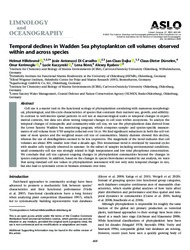Temporal declines in Wadden Sea phytoplankton cell volumes observed within and across species
Dürselen, Claus‐Dieter
Rönn, Lena
DOI: https://doi.org/10.1002/lno.12005
Persistent URL: http://resolver.sub.uni-goettingen.de/purl?gldocs-11858/9893
Persistent URL: http://resolver.sub.uni-goettingen.de/purl?gldocs-11858/9893
Supplement: https://doi.org/10.5281/zenodo.5799263
Hillebrand, Helmut; Antonucci Di Carvalho, Josie; Dajka, Jan‐Claas; Dürselen, Claus‐Dieter; Kerimoglu, Onur; Kuczynski, Lucie; Rönn, Lena; Ryabov, Alexey, 2021: Temporal declines in Wadden Sea phytoplankton cell volumes observed within and across species. In: Limnology and Oceanography, Band 67, 2: 468 - 481, DOI: 10.1002/lno.12005.
 |
Dokument öffnen: |
Cell size is a master trait in the functional ecology of phytoplankton correlating with numerous morphological, physiological, and life‐cycle characteristics of species that constrain their nutrient use, growth, and edibility. In contrast to well‐known spatial patterns in cell size at macroecological scales or temporal changes in experimental contexts, few data sets allow testing temporal changes in cell sizes within ecosystems. To analyze the temporal changes of intraspecific and community‐wide cell size, we use the phytoplankton data derived from the Lower Saxony Wadden Sea monitoring program, which comprises sample‐ and species‐specific measurements of cell volume from 1710 samples collected over 14 yr. We find significant reductions in both the cell volume of most species and the weighted mean cell size of communities. Mainly diatoms showed this decline, whereas the size of dinoflagellates seemed to be less responsive. The magnitude of the trend indicates that cell volumes are about 30% smaller now than a decade ago. This interannual trend is overlayed by seasonal cycles with smaller cells typically observed in summer. In the subset of samples including environmental conditions, small community cell size was strongly related to high temperatures and low total phosphorus concentration. We conclude that cell size captures ongoing changes in phytoplankton communities beyond the changes in species composition. In addition, based on the changes in species biovolumes revealed by our analysis, we warn that using standard cell size values in phytoplankton assessment will not only miss temporal changes in size, but also lead to systematic errors in biomass estimates over time.
Statistik:
ZugriffsstatistikSammlung:
This is an open access article under the terms of the Creative Commons Attribution‐NonCommercial‐NoDerivs License, which permits use and distribution in any medium, provided the original work is properly cited, the use is non‐commercial and no modifications or adaptations are made.

